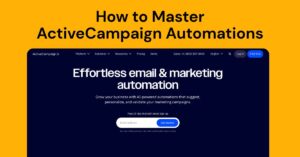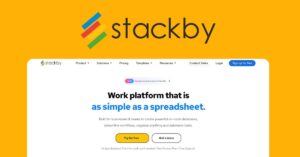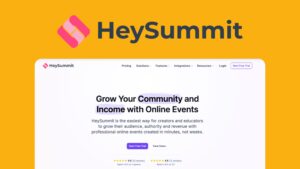Table of Contents
Introduction
Want to know how to use ActiveCampaign Email Automation 2025 can improve your marketing in an industry now worth over $3 billion?
Email marketing drives business growth today. Research shows 75% of consumers prefer retail brands that send customized messages. On top of that, 52% of customers might switch to different brands when companies don’t personalize their communication. These numbers show why becoming skilled at email automation tools matters so much for your marketing strategy.
ActiveCampaign leads the pack and earned “Best Email Tool” and “Best Email Deliverability in 2023” awards recently. The platform features over 20 start triggers for automations that let you create advanced processes based on customer actions. A well-laid-out welcome series can boost engagement by a lot through customized follow-up emails that respond to how users interact with your original messages.
This step-by-step guide covers everything about email automations in ActiveCampaign. We’ll help you tap into the full potential of automation email strategies—whether you’re new or experienced. You’ll learn to set up your first automation triggers and build complex customer experiences.
Understand Email Automation in ActiveCampaign

“Email marketing is a digital strategy that involves sending promotional messages, newsletters, or personalized content to a targeted audience.” — ActiveCampaign Editorial Team, Official editorial team for ActiveCampaign, a leading email automation platform
Email automation changes the way businesses talk to their customers. You need to understand what ActiveCampaign email automation is and why it matters to your business before you start using it.
What is email automation?
Email automation lets you schedule and send targeted emails that trigger automatically based on specific dates, subscriber traits, or user behaviors. Your messages reach people at the right time without your constant input, unlike manual email sending. This creates individual-specific communication automatically.
These automated email sequences (sometimes called workflow automations) respond smartly to actions such as:
- Form submissions
- Website visits
- App interactions
- Purchase behaviors
- Subscription changes
Automation’s power comes from delivering emails when recipients need them most. This perfect timing boosts engagement metrics and return on investment compared to regular email campaigns.
Why automation matters for small businesses

Small businesses with limited resources benefit greatly from email automation. It helps create professional email campaigns that reach thousands of subscribers with minimal investment. This makes it more economical than paid advertising and often delivers better results.
Email marketing gives you the highest ROI among digital marketing channels. Average order values are at least three times higher than social media marketing. This exceptional return makes automation valuable for businesses watching their expenses.
Automation saves you time. Your email sequences work round the clock once you set them up, without anyone clicking “send”. You can connect with your audience and nurture prospects while running other parts of your business.
Personalization features create impressive results. Emails with personalized subject lines get 26% more opens than generic ones. Personalized content gets six times more interaction than non-personalized alternatives. About 82% of companies now use automation, making it essential to stay competitive. More about ActiveCampaign? Go
How ActiveCampaign handles automation email flows
ActiveCampaign is a 15-year-old detailed marketing automation platform serving over 150,000 businesses worldwide. The platform stands out with its visual automation builder that helps create sophisticated email flows through a user-friendly interface.

ActiveCampaign helps you build intelligence-driven automated email follow-up, unlike simple drip sequences that treat all contacts the same. Your contacts get different messages based on who they are and what actions they take—creating experiences specific to each individual.
The platform’s automation works around three core elements:
- Start Triggers – These determine when an automation begins (e.g., when someone subscribes to your list or visits your pricing page)
- Actions – What happens within the automation (sending emails, applying tags, etc.)
- Logic – Decision points that create different paths based on contact behavior
To cite an instance, your welcome sequence checks which link a contact clicked in your original email. The system then sends different follow-up messages based on their shown interests.
ActiveCampaign suggests creating several smaller, manageable automations instead of one large one. This makes your workflows easier to maintain and optimize as you learn what appeals to your audience.
Explore Start Triggers and Their Use Cases
Start triggers are the foundations of ActiveCampaign email automations that determine at the time and how your contacts enter your automated workflows. ActiveCampaign offers more than 20 different triggers, and understanding how to use these automation email starting points will boost your marketing results.
Subscribes to a list
This basic trigger starts an automation each time a contact joins a specific list or any list in your account. You can set this trigger to run once or multiple times per contact, which makes it perfect to welcome sequences and onboarding processes.
The setup process is straightforward – select “Subscribes to a list” while creating a new automation, then choose which list should trigger the workflow. But remember, contacts using double opt-in forms won’t enter your automation until they confirm their subscription.
A practical way to use this is by creating a multi-part welcome series that introduces new subscribers to your products or services step by step. This trigger also impacts automation list associations and unsubscribe behavior, so contacts who unsubscribe from emails in this automation will no longer be on the triggering list.
Clicks a link in an Email
This valuable trigger launches automations each time contacts click links in your emails. You can configure it to respond to:
- Clicks in campaign emails (regular broadcasts or automated emails)
- Clicks in 1:1 sales emails (with connected email accounts)
The setup lets you choose either a specific email or “any email,” plus either a specific link or “any link.” This flexibility makes it ideal to create interest-based follow-up sequences based on which resource links your contacts select.
Let’s say someone clicks a webinar registration link without completing signup. You could automatically send them a reminder email. This targeted approach helps increase conversion rates through well-timed follow-ups.
Visits a web page
Site tracking in ActiveCampaign makes shared automations that respond at the time contacts visit specific pages on your website. This behavior-based trigger needs site tracking setup on your domain first.
The configuration options include:
- Exact URLs (yourdomain.com/pricing)
- Wildcard URLs (yourdomain.com/products/* triggers for any product page)
You could send timely offers at the time someone visits your pricing page without purchasing. Another smart strategy creates re-engagement campaigns for abandoned shopping carts by triggering an automation at the time someone visits their cart page without completing checkout.
The tag is added or removed
Tags help you manage contacts flexibly in ActiveCampaign. The “Tag is added” trigger begins an automation at the time a specific tag gets applied to a contact—whether manually, through form submission, or via another automation.
The “Tag is removed” trigger starts workflows at the time tags are taken away from contacts. This works great for re-engagement campaigns when interest tags are removed or to launch new sequences at the time contacts move between pipeline stages.
These triggers will run multiple times for the same contact only if the tag is completely removed before being added again—otherwise, the automation triggers just once on the first application.
Date-based and event-based triggers
Date-based triggers start automations based on dates in contact fields. You can set them to run before, on, or after specific dates, which makes them ideal for:
- Birthday or anniversary campaigns
- Membership renewal reminders
- Event preparation sequences
The system checks contact records daily to find matches to your date criteria and adds them to your workflow automatically.
Event-based triggers respond to custom events you create, usually user behaviors in your application or website beyond simple page visits. These specialized triggers create targeted automations that respond exactly to specific user actions.
Becoming skilled at these triggers helps you create responsive email automations that deliver the right message at the time your contacts need it—that’s what makes ActiveCampaign email automation work so well.
Build a Welcome Series Automation

Welcome emails get some of the highest open rates compared to other email types. They’re perfect to start learning ActiveCampaign email automation. Let’s create a complete welcome sequence that adapts to how your subscribers interact with your emails.
Set up a trigger for new subscribers
A “Subscribes to a list” trigger forms the base of any welcome series. This simple yet powerful trigger helps onboard new contacts smoothly. Here’s how to create your welcome automation:
- Go to “Automations” and click “New Automation”
- Choose “Subscribes to a list” as your trigger
- Pick your target list from the dropdown menu
- Make the trigger run “Once” to avoid duplicate welcomes
This setup will start your welcome sequence right after someone joins your list. Your new subscribers are most attentive during this time, making it perfect for engagement.
Send a sequence of onboarding emails
Now that your trigger is ready, let’s build the email sequence. A good welcome series usually has 4-6 emails that help new subscribers get to know your brand step by step:
Start by sending your first welcome email. Give subscribers what they signed up for, tell them what to expect, and introduce yourself. Add a 2-7 day gap before you send more messages.
Your welcome sequence could look like this:
- An introduction email that delivers value right away
- Educational content about what you offer
- Stories that help people connect with your brand
- Simple calls to action that get people involved
Use if/else conditions to segment based on engagement
ActiveCampaign’s email automations really shine through conditional logic. You can add an “If/Else” condition after your welcome email to track how people respond:
- Click the plus icon after your welcome email
- Pick “Conditions and Workflow” then “If/Else”
- Set up the condition to check if people clicked your email links
- Add an “Early Engagement” tag for those who clicked (the “Yes” path)
- Send different content to non-clickers through the “No” path
This branching method spots engaged subscribers early and helps you customize future emails. You can add another If/Else check after your second email to create more targeted paths based on how people keep engaging.
Remember to use tags to track engagement levels. These tags will help you create specific segments for future campaigns or automation triggers.
Optimize Your Automation for Better Results
Your ActiveCampaign automation workflows need optimization to boost their performance. Simple techniques can help you get better results and more involvement from your email campaigns.
Use lead scoring to prioritize contacts
Lead scoring helps you rank potential customers by their buying likelihood. Think of it as a temperature gage that shows you which high-value contacts need your attention first.
ActiveCampaign lets you add points based on how contacts behave:
- Website visits (especially pricing pages)
- Email opens and clicks
- Content downloads
- Form submissions
Your scoring model should trigger automations when contacts hit specific scores. A lead that reaches 50 points could trigger an alert to your sales team. Sales representatives can then focus on the most promising leads without any guesswork.
Add dynamic content for personalization
Dynamic content makes your emails unique to each recipient and leads to higher engagement. You can send one email that shows different content based on who receives it.
Your personalization options include:
- Conditional content – Shows specific sections based on contact details and tags
- Personalization tags – Adds custom data like names or priorities
- Predictive content – Uses AI to pick content that appeals most to each recipient
Companies see great results with dynamic content. Timberland sends product recommendations based on their subscriber’s jobs. Brooks changes images based on local weather.
Test subject lines and CTAs
Subject lines make a big difference in open rates. A 5% increase in open rates (from 20% to 25%) means 500 more readers on a 10,000-person list. Testing becomes vital here.
ActiveCampaign’s split testing lets you compare:
- Subject line variations
- CTA button formats and placements
- Send times
- Email content blocks
Define what makes a test successful based on your goals – opens, clicks, or conversions. Use these winning elements in future campaigns to make them better.
Advanced Tips for Scaling Automations
“These integrations enable more sophisticated automation workflows based on customer purchase behavior, abandoned carts, and product interactions, allowing for highly targeted and personalized marketing campaigns.” — GetCensus Research Team, Research and analysis team at GetCensus, a data automation and integration platform
You’ve mastered the simple steps of ActiveCampaign email automation. Now let’s get into advanced features that will help you scale your efforts. These techniques transform your automations from basic sequences into sophisticated marketing systems.
Use goals to track automation success
ActiveCampaign’s goals serve two purposes: they measure marketing effectiveness and enable auto-progression. Adding a goal action to automations lets you:
- Track completion rates to review campaign success
- Move contacts right away to another location when they meet specific conditions
- Pull contacts from any automation point straight to the goal step
- Skip unnecessary emails for contacts who’ve taken desired actions
Goals make it easier to determine success. To name just one example, when welcoming new subscribers with a free download offer, you can send emails until contacts complete the goal of clicking the download link. The contacts jump straight to that step and skip remaining emails once they achieve the goal.
Chain automations together for complex experiences
Multiple automations connect through split actions and conditions to build sophisticated customer experiences. ActiveCampaign suggests developing several smaller, manageable automations instead of one massive workflow. This approach makes optimization and maintenance easier.
Split and conditional actions let you guide contacts through different paths based on their behaviors. You can:
- Create forks that send relevant content based on engagement
- Set up limited-time offers that end after reaching sales targets
- Test different promotions at once and track which gets more and thus encourages more engagement
These versatile tools help build integrated customer experiences without overwhelming complexity.
Monitor performance with reports and analytics
ActiveCampaign’s reporting tools help improve email automations through regular analysis. The Automations Performance report gives complete data about contacts entered, open rates, click rates, and bounce rates.
Individual automation reports offer deeper insights by showing:
- Contact completion rates (how many finished the automation)
- Email metrics per campaign within the automation
- Time-series data showing daily sends, opens, and clicks
These reports can be exported to analyze data outside ActiveCampaign. Regular monitoring helps identify which automations drive results and which need refinement—the foundations of scaling email marketing success through steady improvement.
Conclusion
Becoming Skilled at ActiveCampaign Email Automation for Business Growth
Email automation is a powerful tool in your marketing arsenal. This piece explores how ActiveCampaign email automation works, from simple concepts to advanced implementation strategies.
Without doubt, automation revolutionizes standard email marketing into tailored, responsive communication that delivers messages at crucial moments. You can create customer trips with the platform’s versatile trigger options, and conditional logic will give each subscriber content that matches their needs.
Your email automation needs constant attention to succeed. Subject line tests, performance metric tracking, and automation refinements based on information will improve your results substantially over time. Lead scoring and dynamic content personalization can also boost engagement rates and conversions.
Your automations should work as evolving assets rather than set-and-forget campaigns. True power comes when you optimize based on subscriber behavior. Your email marketing becomes more effective as you learn what appeals to your audience.
The principles stay consistent whether you start with a basic welcome sequence or build complex multi-automation trips: deliver value, respond to behavior, and measure results. Start implementing these strategies one by one. Build your automation expertise while your business benefits from more efficient, tailored customer communication. So, now we know How to Use ActiveCampaign Email Automation. So, let’s set up now
FAQs
Q1. How do I set up my first automation in ActiveCampaign? To start an automation in ActiveCampaign, create a new automation, select a start trigger (like “Subscribes to a list”), add actions such as sending an email, and customize your message. You can then add conditions like wait times or if/else statements to create a more complex workflow.
Q2. What are the key benefits of email automation for small businesses? Email automation offers several advantages for small businesses, including cost-effectiveness, time-saving, and higher ROI compared to other marketing channels. It allows for personalized communication at scale, leading to better engagement rates and potentially higher order values.
Q3. How does ActiveCampaign’s automation differ from basic email campaigns? Unlike standard email campaigns that are sent manually, ActiveCampaign’s automations are triggered by specific subscriber actions or behaviors. This allows for more targeted, personalized, and timely communication based on how contacts interact with your emails or website.
Q4. Can I personalize my automated emails in ActiveCampaign? Yes, ActiveCampaign offers various personalization options. You can use dynamic content to tailor email content based on subscriber data, implement conditional logic to send different messages based on user behavior, and use personalization tags to insert custom field data like names or preferences.
Q5. How can I measure the success of my email automations? ActiveCampaign provides comprehensive reporting tools to track automation performance. You can monitor metrics such as open rates, click rates, and completion rates. The platform also offers individual automation reports showing contact progression through your workflow, helping you identify areas for improvement and optimization.





